Sarah Emsley's Blog, page 7
November 13, 2024
L.M. Montgomery’s Poem “The Gable Window,” by Hughena Matheson
“Prince Edward Island . . . is really a beautiful Province—the most beautiful place in America,” L.M. Montgomery wrote in her autobiography The Alpine Path. Islanders and visitors will no doubt agree with Montgomery, who had a special window onto the Island’s beauty.
She often looked out at the Island landscape from the upstairs gable window in the Cavendish home where she lived with the Macneills, her maternal grandparents.
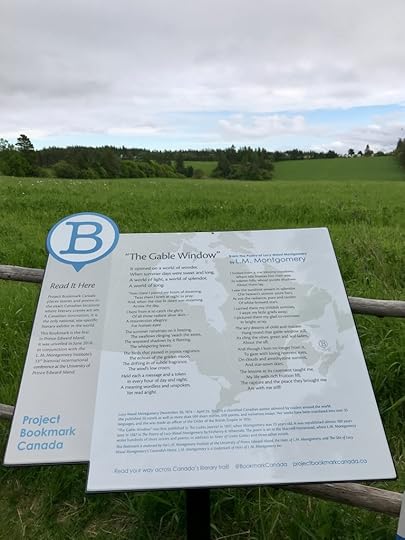
“The Gable Window,” by L.M. Montgomery, reproduced on a Project Bookmark Canada plaque at the Macneill Homestead, Cavendish, PEI
(From Sarah: This is the sixth guest post in “‘A world of wonderful beauty’: L.M. Montgomery at 150,” which began on October 30th and will continue through to Montgomery’s birthday, November 30th. You can find all the contributions to the blog series here . I hope you’ll join the conversations about LMM in the comments here and on social media: #LMM150. Thanks for celebrating Montgomery’s birthday with us!)
A few years ago, my husband and I made a trip to Prince Edward Island. Besides the usual tourist attractions, I wanted to visit that very spot, the Macneill Homestead, now a National Historic Site.
I remember the day we arrived at the homestead. It was just after the busy tourist season, and we had the whole area to ourselves. What a peaceful day! We could wander the area without crowds of other tourists.
I was excited to visit the plaque inscribed with Montgomery’s poem “The Gable Window.” I am a member of the Board of Project Bookmark Canada, the small organization that is creating a literary trail across Canada. This unique trail is marked with plaques (Bookmarks) with a poem or passage from fiction installed in the exact location the writers imagined when writing the words.
As I was reading “The Gable Window” in the very place Montgomery imagined when writing her poem, I looked at the scene in front of me. I felt I was back when the writer lived there. An Islander had told me that apparently, the scene had not changed much over the years.
The poem describes the view as it was in 1897 when twenty-three-year-old Montgomery had her poem published in The Ladies Journal. “It opened on a world of wonder,” she writes, “When summer days were sweet and long, / A world of light, a world of splendor, / A world of song.”
Dr. Elizabeth Epperly, a Montgomery scholar and founder of UPEI’s L.M. Montgomery Institute, had suggested “The Gable Window” poem to Project Bookmark. Why this poem? Epperly writes: “There are so many lush and beautiful passages describing the Macneill place in the Anne and indeed Emily books. And right there is where the Montgomery fan experiences that ‘I know this place’ feeling and a sense of awe. The poem describes the exact fields outside her window.”

Dr. Elizabeth Epperly, speaking at the unveiling of the L.M. Montgomery Bookmark, June 24, 2018
Kate Macdonald Butler, President of the Heirs of L.M. Montgomery (Inc.), was very supportive of the Cavendish Bookmark: “The Heirs of L.M. Montgomery are delighted that the first official Bookmark on Prince Edward Island will honour L.M. Montgomery, and be on the Macneill site in Cavendish she loved so much—where she wrote hundreds of short stories and poems in addition to Anne of Green Gables and three other novels.”
I read the poem a few times and, just like Anne Shirley, Montgomery’s famous fictional redheaded Islander, who loves poetry that “gives you a crinkly feeling up and down your back” (Anne of Green Gables, Chapter 5), I got a “crinkly feeling” up and down my back.

Hughena Matheson was born and raised in Sydney, Cape Breton. She received a B.A. from Mount Allison University and then studied at the Ontario College of Education. For many years, Hughena taught English and Peer Tutoring in Ontario high schools. She was presented with a Prime Minister’s Award for Teaching Excellence (Certificate of Achievement) for 2001 – 2002, mainly for her work with Peer Tutoring. After retirement, Hughena worked for Rubicon Publishing, writing and editing for their series The 10. She also worked for Vitalink Canada Inc., marketing and selling educational materials to schools across Canada.
Hughena has served on the Board of Directors of Project Bookmark for many years, now in the position of president. She has written several articles about Bookmark for numerous newspapers across Canada. Also, she frequently writes opinion pieces for The Hamilton Spectator. She sent me this photo, taken when she and her husband visited the L.M. Montgomery Bookmark:
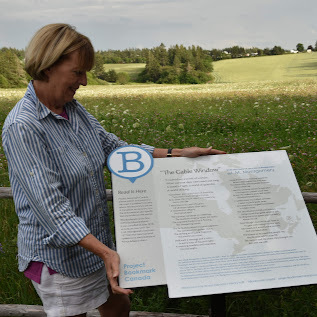
I (Sarah) took the photos of the L.M. Montgomery Bookmark, the unveiling ceremony, and lupines that appear earlier in this blog post. Since 2014, I’ve been volunteering with Project Bookmark Canada; you can read more about our Nova Scotia Reading Circle for Project Bookmark in this article Hughena wrote in 2017 for the organization’s newsletter. We meet at The Old Triangle pub in downtown Halifax, which we chose because it’s in the building where Montgomery worked as a journalist for the Daily Echo when she lived here from 1901 to 1902. Our group is currently working toward a Bookmark for Budge Wilson, author of several books, including a brilliant prequel to Anne of Green Gables entitled Before Green Gables.
Here’s a photo of Hughena and me in Toronto at the Bookmark for Ken Babstock’s poem “Essentialist” (taken by my daughter in the summer of 2023):
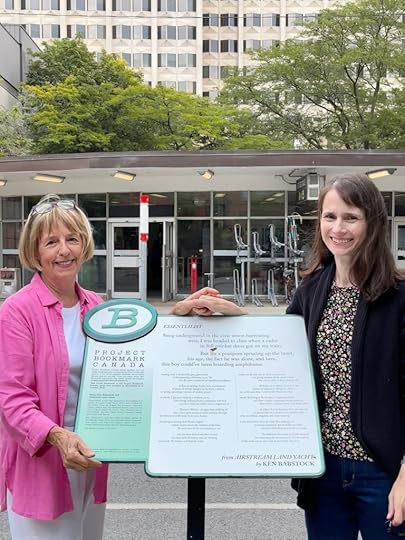
And here’s one more picture I took in PEI on the day the Montgomery Bookmark was unveiled:

If you enjoyed this post, I hope you’ll consider recommending it to a friend. If you aren’t yet a subscriber, please sign up to receive future guest posts in “‘A world of wonderful beauty’: L.M. Montgomery at 150.” The next post, “Discovering Anne of Green Gables in Tel-Aviv,” is by Nili Olay.
Here are the links to the last two posts, in case you missed them.
Anne Lives On, by Naomi MacKinnon
People Who Love Our Places, by Logan Steiner
![Blue sky and green trees at Cavendish Grove, PEI; “‘A world of wonderful beauty’: L.M. Montgomery at 150”]](https://i.gr-assets.com/images/S/compressed.photo.goodreads.com/hostedimages/1730366883i/36120813._SX540_.jpg)
Read more about my books, including St. Paul’s in the Grand Parade, Jane Austen’s Philosophy of the Virtues, and Jane Austen and the North Atlantic, here.
Guest post copyright Hughena Matheson 2024; additional text copyright Sarah Emsley 2024 ~ All rights reserved. No AI training: material on http://www.sarahemsley.com may not be used to “train” generative AI technologies.
November 12, 2024
Anne Lives On, by Naomi MacKinnon
Prince Edward Island has been a part of my life since I was young; growing up in Nova Scotia made it an easy vacation destination. (Although I’m sure it didn’t always feel easy to my parents, who had to drive for nine hours with six children in the back of the vehicle.) We had camping friends whom we met on the Island when we could.

Between the two families, there were ten children and we liked to think the campground belonged to us alone. In those days, we camped at Stanhope campground, which was much less busy than Cavendish area, and one thing the grown-ups all seemed to agree on was that “tourist traps” were to be avoided. When we thought of PEI, we thought of Stanhope, the red sand beach across the road, the warm squishy tar filling the cracks in the road that we’d squeeze our toes into as we crossed, the wild raspberry bushes, games of hide-and-seek in the dark, and sunburns (at least, I think of the sunburns).

Stanhope Beach, 1981. That’s me at the back with the long white hair. My friend is sitting in front of me, to the right.
(From Sarah: This is the fifth guest post in “‘A world of wonderful beauty’: L.M. Montgomery at 150,” which began on October 30th and will continue through to Montgomery’s birthday, November 30th. You can find all the contributions to the blog series here . I hope you’ll join the conversations about LMM in the comments here and on social media: #LMM150. Thanks for celebrating Montgomery’s birthday with us!)
Stanhope had a private campground—with cottages—up the hill behind ours that had its own little camping store. It had matches and hats, flip-flops and candy. But it also had a single, rotating book stand that—in my memory—held all of L.M. Montgomery’s books. In truth, it probably also held romances and mysteries, but I don’t remember those. My friend and I would climb the narrow path up the steep hill that was hidden in the bushes and stunted trees, and we would slowly spin that book stand, discussing which books we already had and which ones we still needed to get. My mother would let me pick one out each summer; sometimes—if I was really lucky—I might even get two.
L.M. Montgomery and her books felt magical to me. I had no idea how big she really was in the world. For all I cared, my friend and I were her only readers; she was all ours. We considered ourselves “kindred spirits.” We read the books together and—when apart—wrote letters to each other detailing what we’d read and what chapter we were on. When we moved on to the later books in the series, I felt secretly proud that my mother had six children just like Anne, and I spent hours (there was no internet back then) thinking up names for the children I was going to have some day, vowing to name them all after characters in Montgomery’s novels. (Needless to say, that didn’t happen. I do not have a daughter named Anne Cordelia. But my husband’s name is Matthew!)

My own kids in front of Green Gables, Summer 2010
It’s only natural that other Anne-lovers who have grown to become children’s authors would want to share their own love of the daydreaming, word-loving, magical character that is Anne, and the world of everything that is L.M. Montgomery, with young readers. Now that it’s in the public domain, they can, they have, and they do.
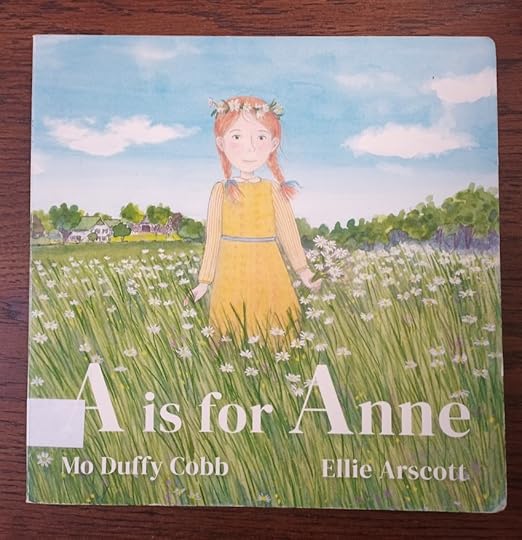
A is for Anne by Mo Duffy Cobb and Ellie Arscott is a lovely alphabetical introduction to Anne for young children. The succession of lyrics and illustrations follows the general storyline of Anne of Green Gables. The illustrations evoke the “Anne feeling” and general sense of the story, which an adult can feel free to elaborate on as their child grows. And I love that the illustrations include a more diverse group of children in Avonlea than the original story has, allowing children to imagine a better-represented version of the good folks of Avonlea.
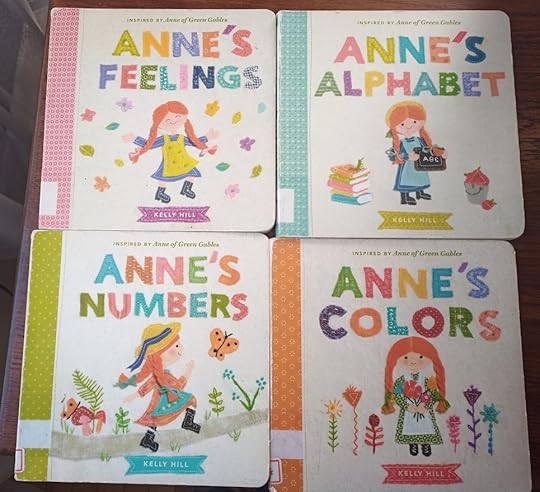
Also for young children is a set of four board books by Kelly Hill that cover basic concepts: letters, numbers, colours, and feelings. The illustrations are sweet quilted and embroidered depictions of Anne doing some of the things she does best: walking a rooftop, jumping on poor Aunt Josephine, wearing puffed sleeves, climbing trees, daydreaming, pouring raspberry cordial for Diana, and going home to Matthew and Marilla at Green Gables. In Anne’s Feelings, my favourite of the four books, Anne lies face down on her bed in the “depths of despair,” “Anne is angry” as she lifts a slate up over her head, “Anne is scared” as she walks through the haunted wood with Diana, and “Anne is surprised” when her hair turns green. Delightful!

Moving on from basic concepts, author Kallie George and illustrator Genevieve Godbout have published picture books for children that include more words to accompany the illustrations. Rather than trying to tell the whole story in a picture book, George has chosen a focus for each book. If I Couldn’t Be Anne focuses on Anne’s excellent imagination, each page illustrating what she would like to be if she couldn’t be herself, while very much keeping Anne’s sentiments and personality. She might like to be the wind “dancing around the treetops,” “a lily maid, drifting dreamily through the summer,” or perhaps “an invisible friend who lives in a book.”
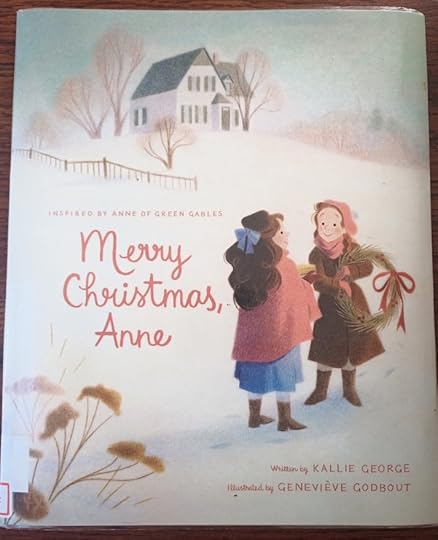
In Goodnight Anne, Anne does not want to go to sleep until she’s said goodnight to everyone she loves, including the Snow Queen and the Lake of Shining Waters. And, of course, Christmas in Avonlea is a very special time, and different from what children experience today. In Merry Christmas Anne, Anne puts on her new dress with the puffed sleeves as she gets ready to recite her poem at the Christmas concert. She uses words like “elegant” and “splendid” and is thankful for the “kindred spirits” who aren’t as “scarce” as she once thought.
Children will not need to wait until they are old enough to read the original novel to dream about sleeping in a wild cherry tree or to thrill over the names of the White Way of Delight and the Lake of Shining Waters with these books in their lives.

School-aged children can learn about Anne in small chunks as they read beginner chapter books written by Kallie George and illustrated by Abigail Halpin. Anne Arrives tells the familiar story of Anne coming to Green Gables by accident, including her outburst at Mrs. Lynde when she’s criticized about her looks. Much of the text is taken from the original, just condensed with a colourful illustration on each page.
Anne’s Kindred Spirits tells the tragic story of the brooch and the Sunday School picnic. And I’m sure you can guess which story is told in Anne’s Tragical Tea Party. Finally, Anne’s School Days includes the famous story of Anne breaking the slate over Gilbert’s head after he calls her “Carrots,” as well as his humiliating rescue of her from the river after she had been playing the lily maid.
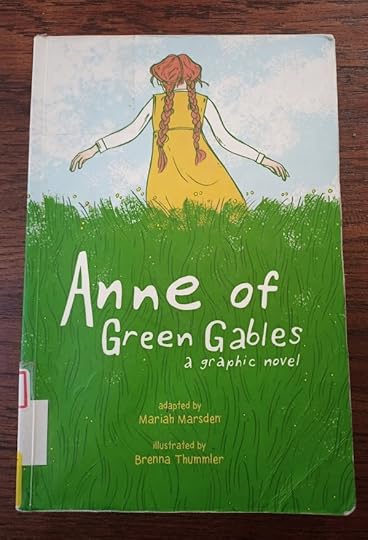
With the arrival of Anne of Green Gables: a graphic novel adapted by Mariah Marsden and illustrated by Brenna Thummler, reluctant readers no longer need to be left out of the pleasure of Anne’s story. Between the words and the illustrations, it covers all the bases of the original. Instead of the descriptive passages, there are beautiful illustrations to give readers that special Prince Edward Island feel.
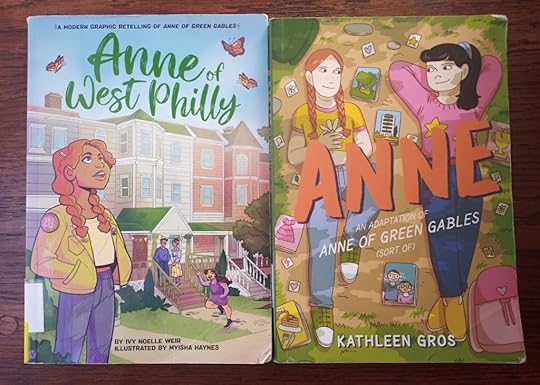
The biggest treat for me was reading the two graphic novel adaptations of Anne of Green Gables. I was unexpectedly taken by them; I enjoyed comparing them with the original story as well as with each other, and I loved discovering their unique perceptions of the characters.
Anne: an adaptation of Anne of Green Gables (sort of) by Kathleen Gros features a contemporary Anne who goes to live with Matthew and Marilla at the Avon-lea apartment building as a foster child. Matthew is the handyman at the Avon-lea and Marilla is an accountant: a very stylish one. Anne’s various adventures are given a modern makeover, but some incidents remain remarkably the same.
Anne of West Philly by Ivy Noelle Weir and illustrated by Myisha Haynes is also a contemporary Anne makeover. I was surprised by the similarities between the two graphic novels, both published in 2022. Again, Anne is a foster child being taken in by Matthew and Marilla, although she’s a year or two older in this version. In both versions, Anne and Gilbert are assigned by their teacher to work together on a big project, which leads to their reconciliation.
In both of the adapted graphic novels, Anne’s love interest is someone other than Gilbert. Part of me is pleasantly surprised and excited about this, but the other part of me—the nostalgic part of me—is sad to see them remain no more than friends and wonders where Gilbert will end up without Anne.
You can see by the illustrations that these graphic novels are ethnically and aesthetically different from one another. But, in both, the spirit of the story remains. Anne is smart and energetic with a lot to say; she has big emotions and a big heart. She remains a kindred spirit.
As a progressive herself, I like to think that L.M. Montgomery would approve of these updated versions of her book as they not only treasure the spirit of friendship, but carry on the spirit of progress as well.

Me and my daughters on the beach in Cavendish, 2022
Naomi MacKinnon lives in Nova Scotia with her husband, three kids, a dog, three cats, and a bunny. She works in the children’s department at the beautiful Truro Public Library, where she reads all the picture books and plays with the puppets. She blogs about books (mostly Canadian) at Consumed by Ink.
Over the past several years, Naomi and I have co-hosted online discussions of L.M. Montgomery’s novels, including The Blue Castle, Jane of Lantern Hill, The Story Girl and The Golden Road, and Kilmeny of the Orchard. If you’re interested in reading what we and other participants wrote about these books, you can find out more on my L.M. Montgomery in Nova Scotia page.
If you enjoyed this post, I hope you’ll consider recommending it to a friend. If you aren’t yet a subscriber, please sign up to receive future guest posts in “‘A world of wonderful beauty’: L.M. Montgomery at 150.” The next post, “L.M. Montgomery’s Poem ‘The Gable Window,’” is by Hughena Matheson.
Here are the links to the last two posts, in case you missed them.
People Who Love Our Places, by Logan Steiner
The Making of a Story Girl, by Kerry Clare
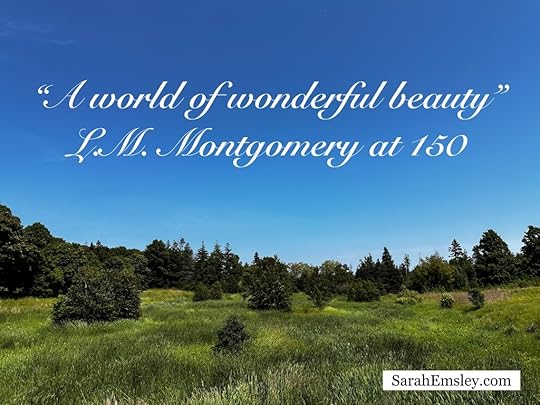
Read more about my books, including St. Paul’s in the Grand Parade, Jane Austen’s Philosophy of the Virtues, and Jane Austen and the North Atlantic, here.
Guest post copyright Naomi MacKinnon 2024; additional text copyright Sarah Emsley 2024 ~ All rights reserved. No AI training: material on http://www.sarahemsley.com may not be used to “train” generative AI technologies.
November 8, 2024
People Who Love Our Places, by Logan Steiner
One trait I share with L.M. Montgomery (who went by Maud), the creator of some of my favorite books, is a love of place so deep that we are always using dressed-up adjectives to try to capture the feeling of them. Places can give us an immediate sense of peace and a far-out perspective. They can show us who we were before, and who we are now.
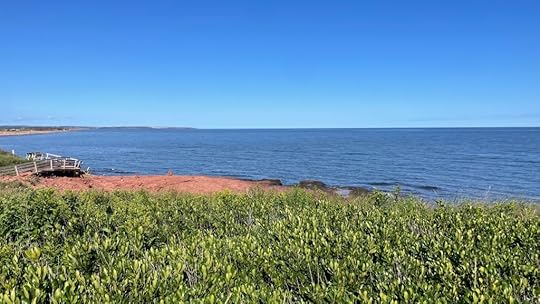
Prince Edward Island
(From Sarah: This is the fourth guest post in “‘A world of wonderful beauty’: L.M. Montgomery at 150,” which began on October 30th and will continue through to Montgomery’s birthday, November 30th. You can find all the contributions to the blog series here. I hope you’ll join the conversations about LMM in the comments here and on social media: #LMM150. Thanks for celebrating Montgomery’s birthday with us!)
We place lovers tend to vacation like robins, returning to the same nest each year. Maud’s dearest place, Prince Edward Island, has become one of my places. I visited when I began researching After Anne, my historical novel based on Maud’s life, and again in the summer of 2023 when the book came out. My mom, two-year-old daughter, and I visited for a third time less than a year later for a three-generations trip I will never forget.

Much has been written about the beauty of the Island and Maud’s books that made it famous. The combination of the two draws flocks of tourists year after year. But being pulled yet again from my home in Colorado to a faraway Canadian destination got me thinking not only about what makes the Island so compelling, but about the kind of people who find it so. What is it about people who love our places?

As I thought about this question, a well-known passage written by Maud late in her life stopped me in my tracks; it contains so much of the answer I was after:
You never know what peace is until you walk on the shores or in the fields or along the winding red roads of Prince Edward Island in a summer twilight when the dew is falling and the old stars are peeping out and the sea keeps its mighty tryst with the little land it loves. You find your soul then. You realize that youth is not a vanished thing but something that dwells forever in the heart. (The Spirit of Canada: Dominion and Provinces, 1939)
Love of place is first about the immediate feeling we have while being there—or better yet, walking there. Maud describes a felt sense of “peace” on Island walks. The Island likewise makes me feel settled inside. My family has its roots in two small Iowa farm-towns, and the Island has a familiar quality. It’s not just the kind of feeling, but the dependability of the feeling, that draws us place-lovers back to the same spots.

Then, too, we return to places that that help us experience, as Maud put it, “the flash” of the “enchanting realm beyond” (Emily of New Moon, Chapter 1). We see the “old stars” peep out, and the sea starts to take on its own character and relationship with the “the little land it loves.” I am always looking for experiences that help me not only remember in my head but feel in my body how old and large the universe is, putting my troubles in perspective. At least for me, these experiences often come when I’m not overwhelmed by new sights and sounds and scents. Not only nature but familiar nature helps me appreciate things like the age of the stars.
And then of course, revisiting places is also a way of revisiting our younger selves. “You find your soul then,” Maud writes, and “realize that youth is not a vanished thing.” This is a gift of returning to an old haunt that we can’t get by visiting a new one. We are never quite the same people we were the last time we visited. Returning to a dear place after a year away is a bit like catching up with a dear friend after a year apart:
It holds up a mirror—reflecting our past selves. A setting can return our youth to us or show us that it never really leaves us. I never spin around in innertubes like I do when we revisit my favorite Iowa lake in the summer.
Returning is also a marker—of how no place or person ever stays exactly the same. Maud’s relationship with the Island became more complicated later in life. She no longer lived there, and her favorite spots turned into tourist destinations. Her visits became both nourishing and heart-wrenching. Revisiting can reveal how our “youth” has become buried or our “soul” has become frayed. Even still, in showing us what we’ve lost and hope to find again, returning to the places we love is a gift.
Quotations are from The Spirit of Canada: Dominion and Provinces, 1939: a souvenir of welcome to H.M. King George VI and H.M. Queen Elizabeth (1939), an essay by L. M. Montgomery; and the Project Gutenberg edition of Emily of New Moon (2020). Photos contributed by Logan.

Logan Steiner is the award-winning and USA Today bestselling author of After Anne (HarperCollins 2023), which tells the story of Lucy Maud Montgomery. Logan also writes a weekly Substack newsletter called The Creative Sort. Her writing has appeared in Lit Hub, Writer’s Digest, Parents Magazine, 5280 Magazine, Nerd Daily, Electric Lit, and Women Writers, Women Books.
After graduating from Pomona College and Harvard Law School, Logan clerked for three federal judges, spent six years in Big Law, and served for three years as an Assistant United States Attorney. She now specializes in brief writing at a boutique law firm. Logan lives in Denver with her husband, daughter, and the cranky old man of the house, a Russian Blue cat named Taggart.

Logan’s essay “What Memory Keeps: Telling the Story of L.M. Montgomery’s Life” was published last month in the Journal of L.M. Montgomery Studies.
If you enjoyed this post, I hope you’ll consider recommending it to a friend. If you aren’t yet a subscriber, please sign up to receive future guest posts in “‘A world of wonderful beauty’: L.M. Montgomery at 150.” The next post, “Anne Lives On,” is by Naomi MacKinnon.
Here are the links to the last two posts, in case you missed them.
The Making of a Story Girl, by Kerry Clare
L.M. Montgomery’s Kindred Spirits, by Mary Beth Cavert
![Blue sky and green trees at Cavendish Grove, PEI; “‘A world of wonderful beauty’: L.M. Montgomery at 150”]](https://i.gr-assets.com/images/S/compressed.photo.goodreads.com/hostedimages/1730366883i/36120813._SX540_.jpg)
Read more about my books, including St. Paul’s in the Grand Parade, Jane Austen’s Philosophy of the Virtues, and Jane Austen and the North Atlantic, here.
Guest post copyright Logan Steiner 2024; additional text copyright Sarah Emsley 2024 ~ All rights reserved. No AI training: material on http://www.sarahemsley.com may not be used to “train” generative AI technologies.
November 6, 2024
The Making of a Story Girl, by Kerry Clare
The first Anne of Green Gables I ever read was a story in the back of a colouring book I’d never put my crayons to, Anne in a few hundred words, an abridgement whose bigger picture still resonated, I assume, because I must have recently seen the movie. This was Kevin Sullivan’s 1985 production, which debuted on CBC TV when I was six, though I actually have no recollection of a time when I hadn’t seen it. And I’m sure I never used that colouring book—beyond the fact that I didn’t like colouring books in general, too little scope for the imagination—because the Anne in its drawings wasn’t Megan Follows, as the Anne of my imagination forever would be.
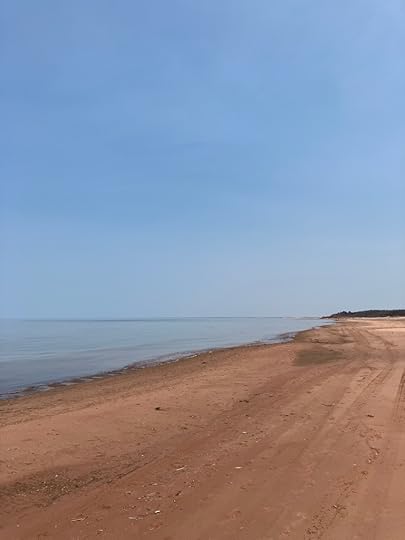
(From Sarah: This is the third guest post in “‘A world of wonderful beauty’: L.M. Montgomery at 150,” which began on October 30th and will continue through to Montgomery’s birthday, November 30th. You can find all the contributions to the blog series here. I hope you’ll join the conversations about LMM in the comments here and on social media: #LMM150. Thanks for celebrating Montgomery’s birthday with us!)
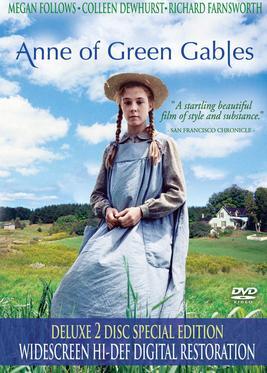
The abridgement, however, would go on to make me famous, however locally. Breaking Montgomery’s novel down to a nutshell, compact enough for me to hold this tale of a feisty orphan in my hand. I wanted to be Anne, and so I decided her abridged tale would be the text on which I based my entry in my school’s storytelling contest, a contest whose prize was a recording of my performance on video cassette, and I was indeed among the winners so immortalized. My story’s climax, I recall, was particularly dramatic, when Anne breaks her slate over Gilbert’s head after he dares to call her “Carrots,” and as a child with a penchant for attention, this entire experience would prove most formative. The works of Montgomery, for me, would always be entwined with both the act and the power of storytelling, as well as a licence to use my voice, to own it.
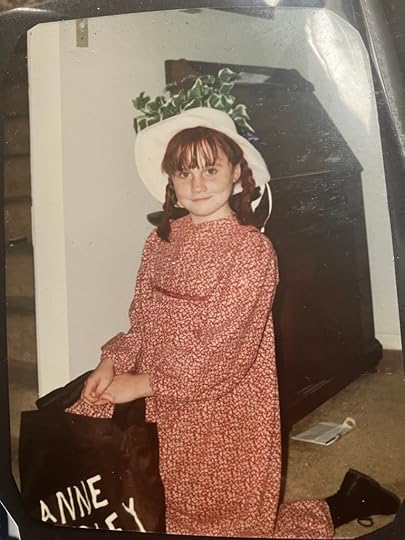
L.M. Montgomery made me a story girl. Throughout so many of her novels, the characters showed me what being a writer entailed, the practical matters, beyond the mere precociousness of declaring oneself as such (though I did that too). It wasn’t simply that Anne and Emily were themselves writers to the marrow, bursting with romantic ideas and florid vocabularies, but that they were unabashed in pursuit of this vocation. In Emily of New Moon, Emily is devoted to practicing writing vivid descriptions in her “Jimmy-books,” which were blank notebooks provided by her supportive cousin. Anne and her friends begin a Story Club in Anne of Avonlea, writing and sharing their own creative works, a conscious act of “cultivating” their imaginations. And I was always fascinated with (and envious of!) the cousins in The Golden Road who manage to create their own household newspaper, full of tales, tips, and teasing, inside jokes and local gossip, and spent my childhood coming up with inferior imitations. Through these different narratives, Montgomery demonstrates not only that a writer is someone who writes, but also how this is done and how storytelling can connect us to each other and the wider community.
![A page from “The Kid Town Times”]](https://i.gr-assets.com/images/S/compressed.photo.goodreads.com/hostedimages/1731076679i/36145679._SY540_.jpg)
In Montgomery’s novels, storytelling is an act of self-preservation, from Anne Shirley’s romantic fantasies during those desperate early years before her arrival at Green Gables to the otherworldly tales Valancy Stirling weaves for herself to survive her years of drudgery and disdain until she’s finally able to escape the clutches of her terrible family.
Stories are also the stitches that hold Montgomery’s imagined worlds together, including the family lore and oral histories conveyed in books like The Blue Castle, A Tangled Web and others. Sometimes these stories are in the background, adding that essential texture that seems to bring fiction to life, and other times they’re the stuff of plot itself—think of the rumours about Barney Snaith in The Blue Castle that compel Valancy to cast off society in The Blue Castle and turn her life into a gothic romance, or Leslie Moore in Anne’s House of Dreams whose own sad story provides her a “tragic air” until a twist of fate (via some cutting-edge neurosurgery) comes along and changes everything.
Anne learns about what happened to Leslie Moore from a most prolific storyteller, Miss Cornelia Bryant, a figure who complicates negative connotations of the local busybody, as she delivers Leslie’s story with kindness and sympathy, though the reader senses that she still revels in the telling: “Well, I may as well begin at the beginning and tell you everything straight through, so you’ll understand it” (Chapter 11).
Stories, sometimes, are just another word for “gossip,” and gossip itself is at the heart of much of Montgomery’s fiction, often delivered, notably, by her most memorable characters. Though there are indeed essential moments when her prolific gossips receive a necessary comeuppance. Note when Rachel Lynde finally meets Anne—newly arrived at Green Gables—and unleashes a torrent of judgement about Anne’s appearance, Anne gives back to her as good as she gets, a beautiful kind of justice, and even Marilla (almost) agrees, in a line at the end of the scene I would have likely glossed over as a young reader (because I think one needs to be older to appreciate the delicate lines with which Marilla’s character is sketched): “She was as angry with herself as with Anne, because, whenever she recalled Mrs. Rachel’s dumbfounded countenance her lips twitched with amusement and she felt a most reprehensible desire to laugh” (Chapter 9).
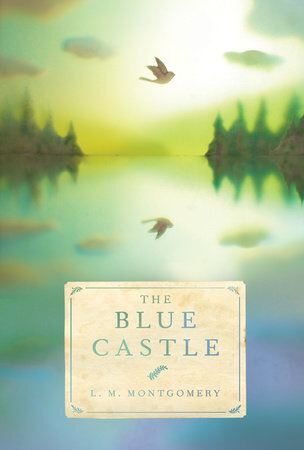
It’s not the act of gossiping that’s the problem, but instead the judgement that might underline it, for which Valancy Stirling calls out her small-minded relatives:
“Can’t you leave poor Cissy Gay alone? She’s dying. Whatever she did, God or the Devil has punished her enough for it. You needn’t take a hand, too. As for Barney Snaith, the only crime he has been guilty of is living to himself and minding his own business. He can, it seems, get along without you. Which is an unpardonable sin, of course, in your little snobocracy.” (Chapter 11)
But it’s not for nothing, I think, that Mrs. Rachel Lynde is the beginning of everything, her very name the opening words of Montgomery’s very first book, and the world begins to be built from her point of view, most literally:
. . . for not even a brook could run past Mrs. Rachel Lynde’s door without due regard for decency and decorum; it probably was conscious that Mrs. Rachel was sitting at her window, keeping a sharp eye on everything that passed, from brooks and children up, and that if she noticed anything odd or out of place, she would never rest until she had ferreted out the whys and wherefores thereof. (Chapter 1)
Rachel Lynde’s kind of discovery is not necessarily malicious, instead sometimes the result of a desire to really understand the world and its workings. This is not the stuff of gossip, instead this is data. Marina Endicott calls it this in her 2023 novel The Observer, when she has her protagonist explain, “But I needed more information, more data—not for gossip, but to understand [her partner’s] situation and my own, to understand and choose how to live my own life.” I think of the gendered element with which gossip is maligned, how the creators of a “Shitty Men in Media” google doc in 2017 (naming alleged perpetrators of sexual assault and sexual harassment) were held to account in ways that shitty men so rarely are—and now I’m thinking of Miss Cornelia again, for reasons that will be clear to anybody who recalls her signature catchphrase.
Rachel Lynde was possibly as much an influence on me as Montgomery’s other more dreamy creations were, showing me that it was also possible to be fierce, and principled, and sometimes wrong, and—even more important—willing to admit to being wrong. Mrs. Rachel was a story girl just as much as Emily Byrd Starr, and just as I don’t think Anne would have been Anne without her, neither would I be the unabashedly gossipy (data-driven!) storyteller I am today.

Kerry Clare is the author of three novels, Asking for a Friend, Waiting for a Star to Fall and Mitzi Bytes, and editor of The M Word: Conversations About Motherhood. A National Magazine Award-nominated essayist, and editor of Canadian books website 49thShelf.com, she is host of the BOOKSPO podcast and writes about books and reading at her longtime blog, Pickle Me This. She lives in Toronto with her family.
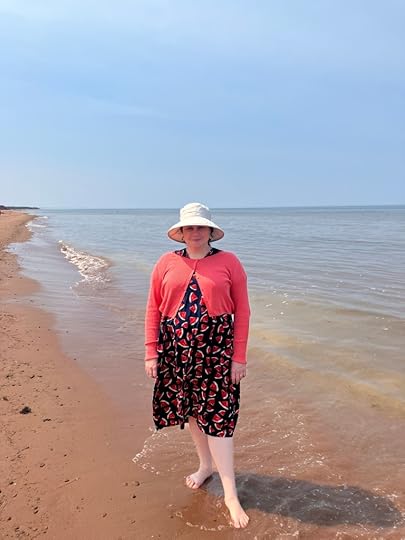
If you enjoyed this post, I hope you’ll consider recommending it to a friend. If you aren’t yet a subscriber, please sign up to receive future guest posts in “‘A world of wonderful beauty’: L.M. Montgomery at 150.” The next post, “People Who Love Our Places,” is by Logan Steiner.
Here are the links to the last two posts, in case you missed them:
L.M. Montgomery’s Kindred Spirits, by Mary Beth Cavert
Welcome to “‘A world of wonderful beauty’: L.M. Montgomery at 150”
![Blue sky and green trees at Cavendish Grove, PEI; “‘A world of wonderful beauty’: L.M. Montgomery at 150”]](https://i.gr-assets.com/images/S/compressed.photo.goodreads.com/hostedimages/1730366883i/36120813._SX540_.jpg)
Read more about my books, including St. Paul’s in the Grand Parade, Jane Austen’s Philosophy of the Virtues and Jane Austen and the North Atlantic, here.
Guest post copyright Kerry Clare 2024; additional text copyright Sarah Emsley 2024 ~ All rights reserved. No AI training: material on http://www.sarahemsley.com may not be used to “train” generative AI technologies.
November 4, 2024
L.M. Montgomery’s Kindred Spirits, by Mary Beth Cavert
It is an honour to participate in another wonderful tribute event to celebrate the 150 years since L.M. Montgomery’s birth. She made a “safe landing on the shores of time” (Rilla of Ingleside, Chapter 28) in a small village in Canada, on a cold and wet late November day in 1874, but her life stories and legacy have flourished in breadth and depth ever since. Her books have never been out of print.
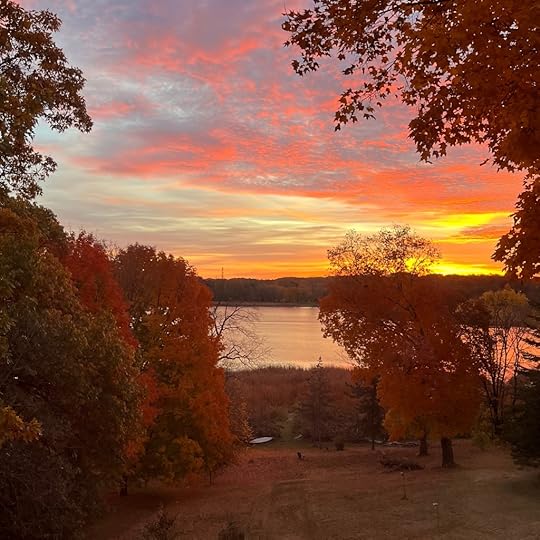
(From Sarah: This is the second guest post in “‘A world of wonderful beauty’: L.M. Montgomery at 150,” which began on October 30th and will continue through to Montgomery’s birthday, November 30th. You can find all the contributions to the blog series here. I hope you’ll join the conversations about LMM in the comments here and on social media: #LMM150. Thanks for celebrating Montgomery’s birthday with us!
The title of the series comes from Montgomery’s description of what Emily Starr calls “the flash” in Emily of New Moon:
It had always seemed to Emily, ever since she could remember, that she was very, very near to a world of wonderful beauty. Between it and herself hung only a thin curtain; she could never draw the curtain aside—but sometimes, just for a moment, a wind fluttered it and then it was as if she caught a glimpse of the enchanting realm beyond—only a glimpse—and heard a note of unearthly music. . . . And always when the flash came to her Emily felt that life was a wonderful, mysterious thing of persistent beauty.)
My mother was a fan of Montgomery; as a child in the 1920s and 30s, she would wait at the train stop in her rural town of fifty people to receive the library book basket so she could get whatever Montgomery book was in it first. However, I never knew this until I entered the Montgomery world on my own after my red-haired daughter was born. It was then that I read all the Montgomery books in paperback and then started to collect first, early, and unique editions. I have had as many as seven hundred on the shelves and find that many of my favourites are ones with inscriptions. The messages share happy times from the past: Jack loved Claudia when he gave her Rainbow Valley, Betty’s mom and dad gave her Anne of Avonlea for Christmas in 1909, Stella got The Golden Road for her birthday in 1925 from Grandma in England, the Malvern Hotel in Bar Harbor, Maine, kept a July 1908 Anne of Green Gables on hand for its guests, Anne’s House of Dreams was awarded to Irene for good grades.
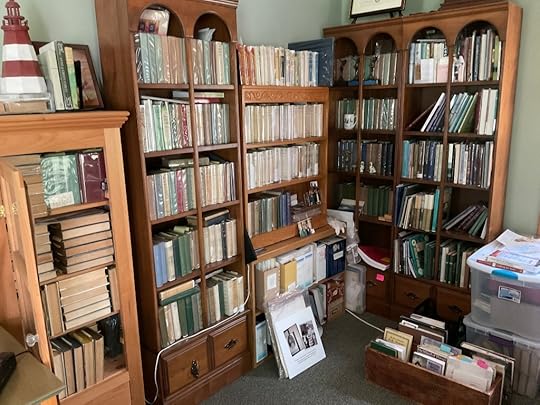
My daughter and I went on a tour of Montgomery sites on PEI in 1992. I visited Maud’s Ontario sites in 1993 (Bala, Norval, Leaskdale, the archives at Guelph University); then I attended the first L.M. Montgomery Institute Conference at the University of Prince Edward Island in 1994. I was hooked. I enjoyed every aspect of Montgomery’s stories immensely and Montgomery’s journals engaged me even more.
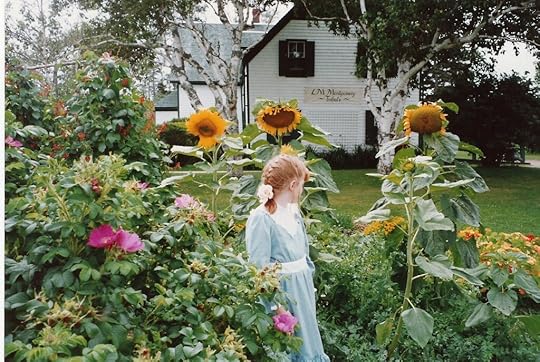
One of reasons that countless readers enjoy and return again and again to L.M. Montgomery’s stories is to wrap themselves up in the relationships and friendship she created in them. Friendship was the door that I chose to enter the imagination of L.M. Montgomery, sparked by the statement of a scholar in 1994 at the Montgomery Conference: “[Montgomery’s] writings are a record of her desire for the kind of friends she craved” (from Mary H. Rubio’s Harvesting Thistles). This statement sparked a question that I wanted to pursue—to explore her friendships, were they absent or full-formed? My key was to use all of her book dedications to examine significant people in her life. And, indeed, I found that Montgomery had many authentic relationships and that she didn’t crave for friends, but craved their presence and mourned their absences.
In 1994 I started to supplement the information in Montgomery’s published letters and the irregular threads about her friends in her journals by contacting the family members of those friends to find letters, hear recollections, and see family artifacts. I also examined numerous, and sometimes conflicting, historical records to support or amend oral histories. There was not the wealth of digital information as there is today. I dug up obituaries and looked up names in telephone books. Then I wrote letters to likely names in those telephone directories. Sometimes I got letters back immediately, and sometimes not until ten years later after a parent died and relatives went through their papers! And, as always, the best help was from librarians!
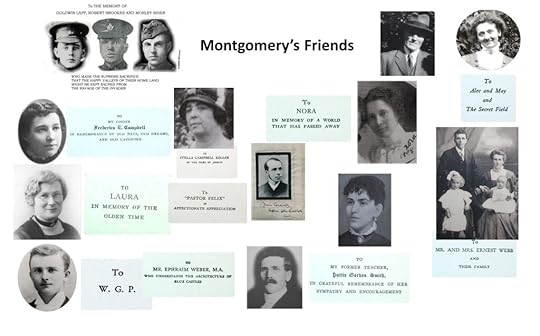
As a result of that research, I was able to reveal the previously unknown life stories of some of her friends at the 1996 Montgomery Institute Conference, which initiated several deeply treasured friendships and collaborations with Elizabeth Waterston, Mary Rubio, and Elizabeth Epperly in Canada, as well as many others world-wide. Afterwards, I was gratified to see that overlooked details that I found, like poet John McCrae‘s presence at Montgomery’s meeting with Lord Earl Grey, had been well-received and that there had been re-evaluations of the importance of her year living in Prince Albert and her friendships with the Pritchard and MacGregor Families. Her relatives have become close to my heart, especially her cousins, Frede, Stella, Bertie, Tillie, and Myrtle. My most surprising early discoveries were the lives of Nora Lefurgey and Hattie Gordon—two accomplished and remarkable people! It has been a wonderful experience to locate some of the dedication families and share with them the importance of their great-grandparent to this famous author.
About ten years ago I was asked to edit the entire collection of Montgomery’s letters to her dear friend in Scotland, George B. MacMillan. (You can find my MacMillan presentation, in my Covid voice, here: About L.M. Montgomery: Mary Beth Cavert: L.M. Montgomery’s Kindred Spirits: The One in Scotland. Hosted by Daniela Janes, Caroline E. Jones, Benjamin Lefebvre, Andrea McKenzie.)

George B. MacMillan
It took a great deal of time and collaboration with my own dear friends to get it ready for a publisher. As happens with all of Maud’s friends, I became very fond of George. The process of research never ends and never fails to surprise. After I finished the whole MacMillan project in 2020, entirely new treasure-troves of their correspondence were uncovered in 2021 and 2024—just in time to slip them into the manuscript!
Now I am working hard to finish the manuscript I started in 1995, L.M. Montgomery’s Kindred Spirits. It will be the story of every one of her book dedications. It is a kind of biography collection, about all the people with whom she formed unbroken bonds early in her life, before she became famous. For me, the stories behind the dedications not only reveal Montgomery’s tight circle of friends, but also illuminate happy aspects of her life that are sometimes overlooked. This long-brewing project has also enhanced my personal life. Maud has given me the gift of friends from all over the world who continue to enrich my spirits far beyond any borders or generations.
Thank you, Sarah, for celebrating Maud!
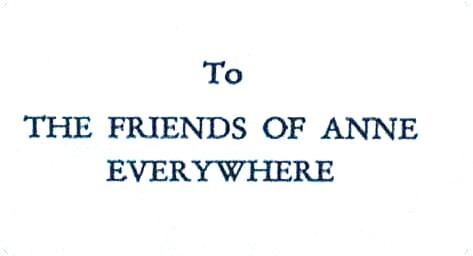
Dedication in Anne of Windy Poplars
Quotations are from Rilla of Ingleside (F.A Stokes, 1921), and Harvesting Thistles: The Textual Garden of L.M. Montgomery: Essays on Her Novels and Journals, edited by Mary Rubio (Canadian Children’s Press, 1994).
Mary Beth Cavert is a recipient of the 2020 L.M. Montgomery Institute Legacy Award. She specializes in the personal, historical, and literary context of Montgomery’s kinship ties. She co-authors and publishes The Shining Scroll and all the L.M. Montgomery Literary Society social media accounts and website. She edited the complete correspondence from L.M. Montgomery to George B. MacMillan, L.M. Montgomery’s Letters to Scotland, and is updating a manuscript of Montgomery’s book dedications, L.M. Montgomery’s Kindred Spirits. She is a member of the editorial board of the Journal of L.M. Montgomery Studies. Her research has been included in The Complete Journals of L.M. Montgomery, and she has been a contributing writer in L.M. Montgomery’s Rainbow Valleys, The Intimate Life of L.M. Montgomery, and The Lucy Maud Montgomery Album.
Mary Beth took the photos of the sunset, her bookshelves, the dedication in Anne of Windy Poplars, and the garden at Green Gables. The images in the Dedications Collage are from the L.M. Montgomery Archival Collections, University of Guelph, Ontario; Lockhart, Lefurgey/Campbell, and Gordon/Smith families; Soldiers—Uxbridge Historical Centre and Canadian Virtual War Memorial. The photo of George B. MacMillan was provided by Duncan MacMillan.
Here’s Mary Beth in Scotland, at Abbotsford, home of Sir Walter Scott:

Mary Beth’s Website
Online @LMMontgomeryLS:
If you enjoyed this post, I hope you’ll consider recommending it to a friend. If you aren’t yet a subscriber, please sign up to receive future guest posts in “‘A world of wonderful beauty’: L.M. Montgomery at 150.” The next post, “The Making of a Story Girl,” is by Kerry Clare.
Here are the links to the last two posts, in case you missed them:
Welcome to “‘A world of wonderful beauty’: L.M. Montgomery at 150”
Anne Shirley and Marianne Dashwood, #KindredSpirits, by Kate Scarth

Read more about my books, including St. Paul’s in the Grand Parade, Jane Austen’s Philosophy of the Virtues and Jane Austen and the North Atlantic, here.
Guest post copyright Mary Beth Cavert 2024; additional text copyright Sarah Emsley 2024 ~ All rights reserved. No AI training: material on http://www.sarahemsley.com may not be used to “train” generative AI technologies.
November 1, 2024
Welcome to “‘A world of wonderful beauty’: L.M. Montgomery at 150”
Welcome to my new blog series, “‘A world of wonderful beauty’: L.M. Montgomery at 150”!

In early October, I promised you maple branches in honour of Anne Shirley and dead leaves in honour of Marianne Dashwood, and here they are:

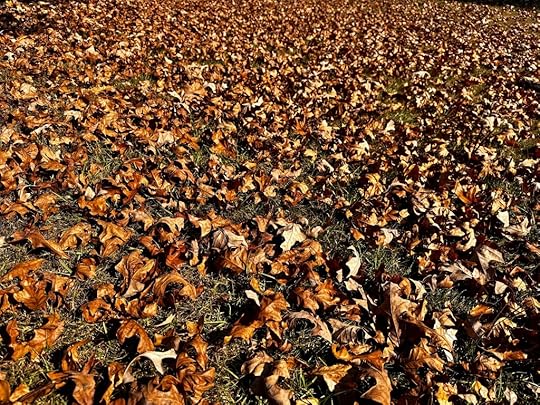
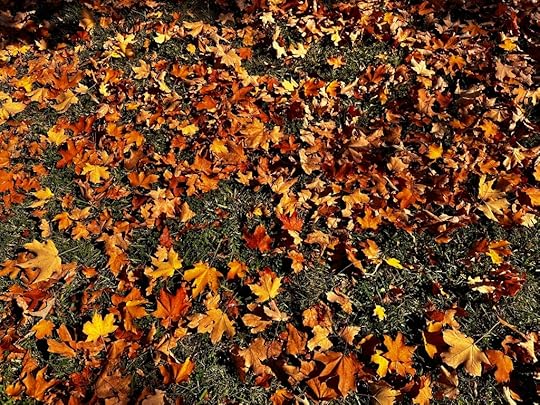
(I took the photo of the maple branches in Halifax, Nova Scotia, a couple of weeks ago and the photos of dead leaves in Lamar Park in Oxford, Mississippi, last weekend.)
Thank you to Kate Scarth for Wednesday’s post on “Anne Shirley and Marianne Dashwood, #KindredSpirits,” which provides a link between my “Summer Party for Sense and Sensibility” and this new series, a month-long celebration of L.M. Montgomery’s 150th birthday.
On Monday, we’ll hear from Mary Beth Cavert, on “L.M. Montgomery’s Kindred Spirits,” followed by two or three guest posts per week, usually on Mondays, Wednesdays, and Fridays.
I too have a contribution for the series, an essay called “Stories, Girls, and ‘The Vanished Years,’” which I’ll share with you at the end of November. It’s a kind of companion piece to the paper I presented at the Jane Austen Society of North America (JASNA) AGM in Cleveland, Ohio, a couple of weeks ago, which was entitled “‘She Placed Her Bonnet on His Head & Ran Away’: Stealing Sources and Avoiding Consequences.” My JASNA paper will be in Persuasions On-Line and I’ll share the link here when the journal is published. Both essays are about stories, their sources, and who owns them.
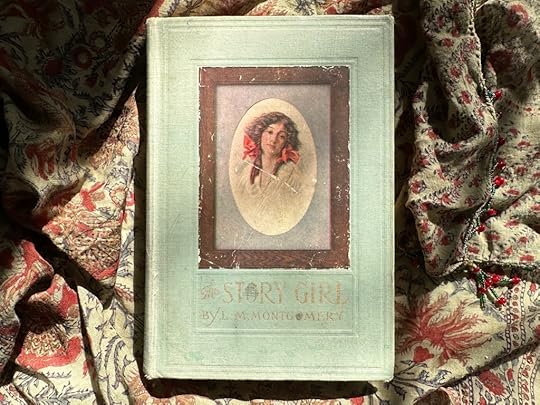
For now, here’s my #Maud150 tribute to Montgomery for her birthday, which was published on the Journal of L.M. Montgomery Studies website in late August:
Dear Maud,
You are like the heroine of Barbara Cooney’s picture book Miss Rumphius, scattering lupine seeds and inspiration, following the advice, “You must do something to make the world more beautiful.” You’ve inspired me and countless others to keep diaries, take photographs, create scrapbooks, write stories, and dedicate our lives to climbing the Alpine Path. You inspired my uncle to tell stories to my cousins, siblings, and me about the adventures of a giraffe named Gerard of Green Gables on our first PEI trip. And you inspired my four-year-old daughter, during a summer we spent immersed in the world of Green Gables, Avonlea, and “Anne” musicals to sing, “You’ve got to go the way that your imagination’s going.” Thank you for inspiring people around the world to be curious and hopeful, even in the face of adversity and sorrow, about what lies beyond “the bend in the road.”
Sarah Emsley
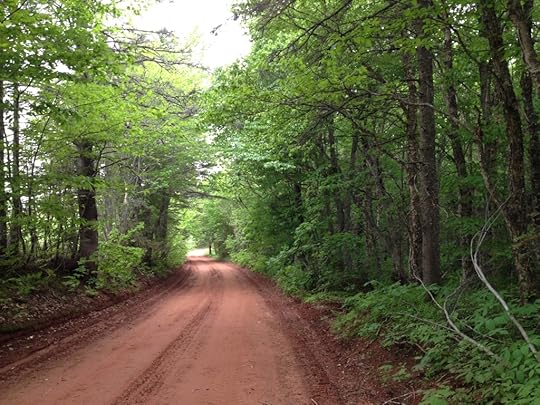
Some of you may be interested in an upcoming online celebration of Montgomery that will be hosted by Susannah Fullerton, President of the Jane Austen Society of Australia. (Tickets available here.) The event includes guest speakers (I’m one of them) and activities. It’s on Montgomery’s birthday, November 30th, and for those of us who live in North America it will take place very early in the morning. Fortunately, the ticket price includes access to the recording, so you could watch it later if you prefer. Susannah invites kindred spirits to pour a glass of raspberry cordial or wine, cut a slice of ruby jelly layer cake, and join the party.

Unrelated to L.M. Montgomery: this coming Tuesday, November 5th, I’ll be speaking in the Evenings @ Government House series about the history of St. Paul’s Church, Halifax. I’ll talk about the founding of the Church, 275 years ago, and the significant role played by St. Paul’s at some key moments in Halifax history, including the relief efforts that followed the sinking of the Titanic in 1912 and the Halifax Explosion in 1917. I’ll also look at the connections between St. Paul’s and Jane Austen’s family: one of her nieces was baptized there in 1809 and one of her nephews was married there in 1848. (The session is free and open to the public; it’s fully booked and the waiting list is also full, but it’s possible that I’ll give the talk again sometime in the coming months.)
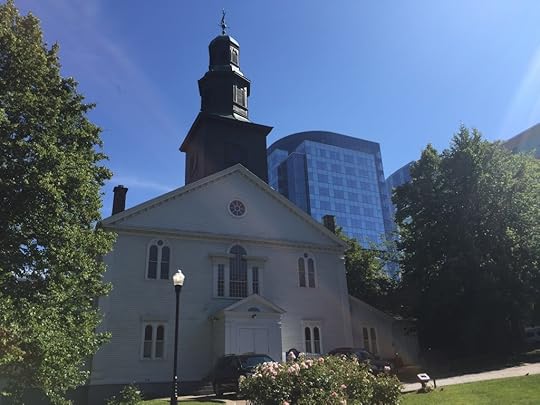
Back to Montgomery again: while sorting through my elementary school notes and art recently, I came across this drawing of Anne Shirley, which I created in the early 1980s, long before construction began on the Confederation Bridge that connects Prince Edward Island and New Brunswick. I guess somehow I must have known what it would look like.

And here’s a photo of me with the L.M. Montgomery statue in Montgomery Park, Cavendish, PEI, taken by my daughter in June, following the L.M. Montgomery Institute conference at UPEI.
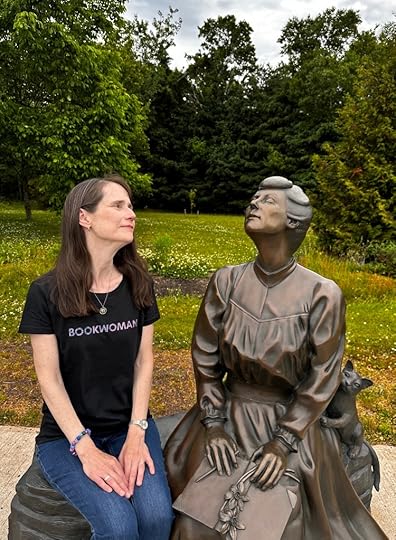
Here are the links to the last two posts, in case you missed them:
Anne Shirley and Marianne Dashwood, #KindredSpirits, by Kate Scarth
“A glorious October, all red and gold” (written by me, quoting Anne of Green Gables)
Read more about my books, including St. Paul’s in the Grand Parade, Jane Austen’s Philosophy of the Virtues, and Jane Austen and the North Atlantic, here.
If you enjoyed this post, I hope you’ll consider recommending it to a friend, and if you aren’t yet a subscriber, please sign up to receive future posts.
Copyright Sarah Emsley 2024 ~ All rights reserved. No AI training: material on http://www.sarahemsley.com may not be used to “train” generative AI technologies.
October 30, 2024
Anne Shirley and Marianne Dashwood, #KindredSpirits, by Kate Scarth
In January 2024, I joined Hayley Solano of the Enchanted Book Club for a webinar called A Celebration of Anne Shirley. Jane Austen’s heroines were the subject of Hayley’s subsequent session, so one of her questions to me was, “is there a Jane Austen heroine that reminds you of Anne?” Appropriately, given my focus on bosom friends here, it was my long-time pal and fellow LMM/Austen fan, Lyndsey Darling, who came up with the answer: Marianne Dashwood!

Book cover of Sense and Sensibility. Signet, 2008.
Various online quizzes, the virtual versions of women’s magazine questionnaires, have featured Montgomery and Austen characters; what if Anne and Marianne themselves did one of these quizzes? Would they be not just similar, but in fact #kindredspirits? Let’s consider the evidence in Montgomery’s Anne of Green Gables (and Anne of the Island) and Austen’s Sense and Sensibility.
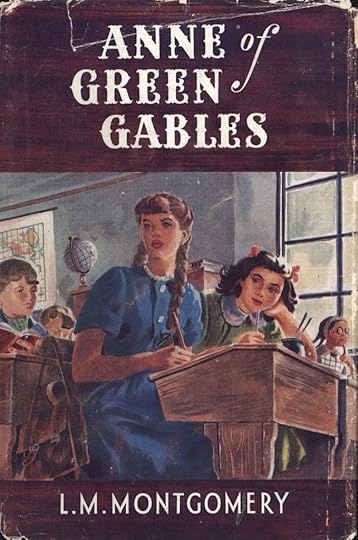
Book cover of Anne of Green Gables. Angus and Robertson, 1954. Ryrie-Campbell Collection, KindredSpaces.ca, 023 AGG-AR.
(From Sarah: This is the first guest post in “‘A world of wonderful beauty’: L.M. Montgomery at 150,” which will continue through to Montgomery’s birthday, November 30th. You’ll find all the contributions to the blog series here. I hope you’ll join the conversations about LMM in the comments here and on social media: #LMM150. Thanks for celebrating Montgomery’s birthday with us!)
You might be a kindred spirit if . . .
You love nature. Have you ever declared in response to a beautiful landscape, “it was like a beautiful dream! It gave me a thrill” (Anne of Green Gables, Chapter 11) or is “there a felicity in the world . . . superior to this?” (Sense and Sensibility, Chapter 9).But you find others aren’t always as enraptured by trees and flowers as you are. Has your friend ever named a pretty place with a “plain” name like Birch Path when you “could have found something more poetical”—think White Way of Delight or Idlewild? (Anne of Green Gables, Chapter 15). When saying good-bye to beloved trees at your beloved childhood home have you ever declared, “But who will remain to enjoy you?” (Sense and Sensibility, Chapter 5).You are the most loyal of friends. Perhaps you have made an oath like: “I solemnly swear to be faithful to my bosom friend, Diana Barry, as long as the sun and moon shall endure” (Anne of Green Gables, Chapter 12). Or when your talented sister is overlooked for another, have you declared, “what is Miss Morton to us?—who knows, or who cares, for her?—it is Elinor of whom we think and speak” (Sense and Sensibility, Chapter 12).You don’t do emotions by half measures. You know what it is to be in the “depths of despair” and to have “several thrills” in response to beauty or in anticipation of new or happy events (Anne of Green Gables, Chapters 3, 16). Or someone has said about you that “her sorrows, her joys, could have no moderation” (Sense and Sensibility, Chapter 1).You love poetry, especially the Romantics. After all, “Don’t you just love poetry that gives you a crinkly feeling up and down your back?”(Anne of Green Gables, Chapter 5). Or have you ever said that your favourite poems’ “beautiful lines . . . have frequently almost driven me wild”? (Sense and Sensibility, Chapter 3).You are appreciated and well loved. When the world tells you to learn lessons, grow up, and adapt yourself to society, you have a Matthew Cuthbert or a Colonel Brandon who doesn’t want you to change too much: “Don’t give up all your romance, Anne . . . a little of it is a good thing—not too much, of course—but keep a little of it, Anne, keep a little of it” (Anne of Green Gables, Chapter 28) or “there is something so amiable in the prejudices of a young mind, that one is sorry to see them give way to the reception of more general opinions” (Sense and Sensibility, Chapter 11).You fall madly in love with the man of your (literary) dreams. Have you ever been rescued on a rainy day by a dark handsome romantic stranger who shares all your tastes? You may later have said, “I was swept off my feet at first by his good looks and knack of paying romantic compliments; and later on I thought I must be in love because he was my dark-eyed ideal” (Anne of the Island, Chapter 38). Or perhaps he boasts “manly beauty and more than common gracefulness” and has “taste,” which in “every point coincide[s] with [your] own” (Sense and Sensibility, Chapters 9, 3).But then you realize that the boy (or man!) next door who loved you all along is the one for you. It was only “flattered fancy” you felt for the dark handsome stranger, and you really love your “old friend,” Gilbert Blythe (Anne of the Island, Chapters 40, 37). Perhaps you saw marriage to an older man as “a compact of convenience,” “no marriage at all,” but later found your “own happiness in forming his” and your “whole heart” becomes devoted to him, your husband, Colonel Brandon (Sense and Sensibility, Chapters 8, 8, 50, 50).You endure. After hearing the words, “Say, Anne, did you know that Gilbert Blythe is dying?” you face losing your dear friend and need to reckon with your own heart (Anne of the Island, Chapter 40). When emotional distress almost leads to your own death—when “Marianne might at that moment be dying” (Sense and Sensibility, Chapter 45)—you experience a change of ideals and attachments. Your happy ending is hard won, happening only after suffering, loss, and near-death.You grow and are challenged and change and mature, but you are still fundamentally yourself. After all, “I’m not a bit changed—not really. I’m only just pruned down and branched out. The real me—back here—is just the same. It won’t make a bit of difference where I go or how much I change outwardly; at heart I shall always be your little Anne, who will love you and Matthew and dear Green Gables more and better every day of her life” (Anne of Green Gables, Chapter 35). And “Marianne could never love by halves; and her whole heart became, in time, as much devoted to her husband, as it had once been to Willoughby” (Sense and Sensibility, Chapter 50).
Book cover of Anne of Green Gables. Parragon, 1994. Ryrie-Campbell Collection, KindredSpaces.ca, 236 AGG-PARRAGON.
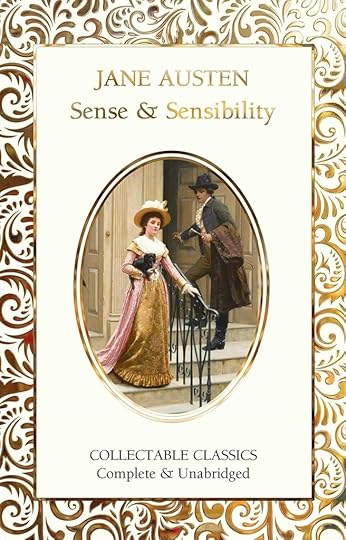
Book cover of Sense and Sensibility. Flame Tree Collectable Classics, 2019.
So, yes: despite differences of time, place, and culture, you, Anne and Marianne, are kindred spirits in your shared love of nature, talent for friendship, and emotional sensitivity. Your story lines and character development reflect shared heritages: you both descend from heroines of sensibility, the Romantic child of nature, the hero of the bildungsroman.

Book cover of Anne of Green Gables and Anne of Avonlea. Sebastian Kelly, 1999. Ryrie-Campbell Collection, KindredSpaces.ca, 281 AGG-AA-ANNESS.
What do you make of Anne and Marianne as bosom friends, as being of the race of Joseph, two other ways that Montgomery conveyed kindred spiritness?
In my chapter in Children and Childhoods in L.M. Montgomery: Continuing Conversations, I paired Emily Byrd Starr and Fanny Price. Which other Montgomery and Austen characters do you think would enjoy a shared glass of raspberry cordial or walk through the sunshiny countryside?
Quotations are from Project Gutenberg editions linked here: Anne of Green Gables, Anne of the Island, and Sense and Sensibility.

Kate Scarth is the Chair of L.M. Montgomery Studies with the L.M. Montgomery Institute, editor-in-chief of the Journal of L.M. Montgomery Studies, and Associate Professor of Applied Communication, Leadership, and Culture at the University of Prince Edward Island. She has published on Montgomery and Jane Austen and with Trinna S. Frever has been collecting fans’ stories of engaging with the world of L.M. Montgomery (see yourlmmstory.com). Learn more: katescarth.com.
In the summer, I took this photo of Kate (below) with a copy of the Thai translation of Anne of the Island (translated by Varavadi V. Monaghan and published by Words Wonder Publishing, 2024). The cover features an image of the Forrest Building at Dalhousie University, which was the only Dalhousie building when Montgomery attended as a student in 1895-96. Redmond College in Anne of the Island is a fictionalized version of Dalhousie.

For my Summer Party for Sense and Sensibility , I asked contributors to send flower photos. Kate took this photo of poppies in Charlottetown, PEI:

If you enjoyed this post, I hope you’ll consider recommending it to a friend. If you aren’t yet a subscriber, please sign up to receive future guest posts in “‘A world of wonderful beauty’: L.M. Montgomery at 150.”

Here are the links to the last two posts, in case you missed them:
“A glorious October, all red and gold”
Read more about my books, including St. Paul’s in the Grand Parade, Jane Austen’s Philosophy of the Virtues and Jane Austen and the North Atlantic, here.
Guest post copyright Kate Scarth 2024; additional text copyright Sarah Emsley 2024 ~ All rights reserved. No AI training: material on http://www.sarahemsley.com may not be used to “train” generative AI technologies.
October 25, 2024
“A glorious October, all red and gold”
I’m quoting from Anne of Green Gables again, from Chapter 24, “Miss Stacy and Her Pupils Get Up a Concert.” Anne delights in the changing leaves, the “mellow mornings,” and the friend she’s found in her new teacher, Miss Stacy, “a bright, sympathetic young woman with the happy gift of winning and holding the affections of her pupils and bringing out the best that was in them mentally and morally.”
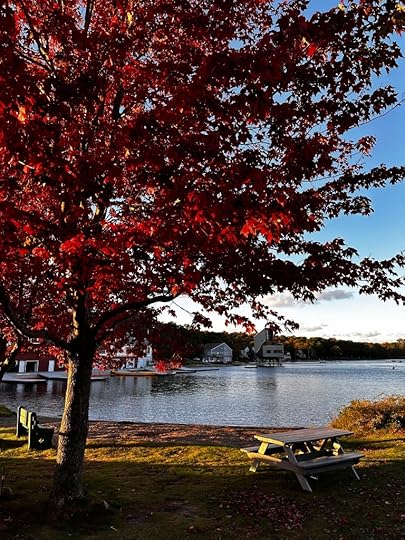
Isn’t it wonderful when students get to study with teachers like this? I think of my own favourite teachers and I feel grateful for all I’ve learned from them. I feel as attached to the “h” at the end of my name as Anne is to her “e,” and I know what Anne means when she says that hearing Miss Stacy pronounce her name, she feels “instinctively that she’s spelling it with an E.” Not everyone pays attention to such details and it’s a real gift when someone does.
I quote from Anne of Green Gables so often that sometimes I feel as if I live in the novel, in the way that my sister Bethie and I talk about “living in Pride and Prejudice.”
I’m excited about celebrating L.M. Montgomery’s 150th birthday with you, beginning next week. On Wednesday, October 30th, the anniversary of the date Jane Austen’s Sense and Sensibility was published, we’ll hear from Kate Scarth on “Marianne Dashwood and Anne Shirley, #KindredSpirits.” My new blog series “‘A world of wonderful beauty’: L.M. Montgomery at 150” will run from through to November 30th.
Sometime after that, I’ll put together a blog post about the fabulous Jane Austen Society of North America AGM that I attended last weekend. Right now, I’m still travelling—visiting Bethie in Mississippi—and so I thought I’d share with you some photos from a glorious October walk at Lake Banook in Dartmouth, Nova Scotia, before I left home.
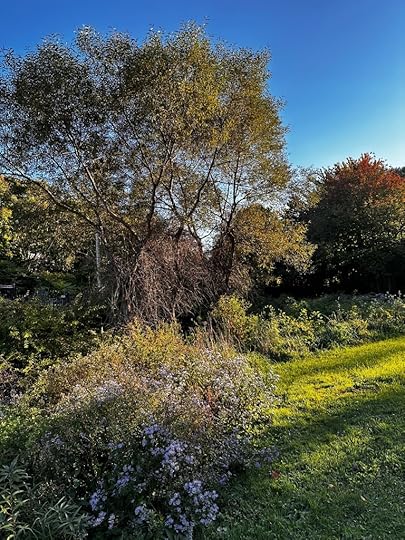
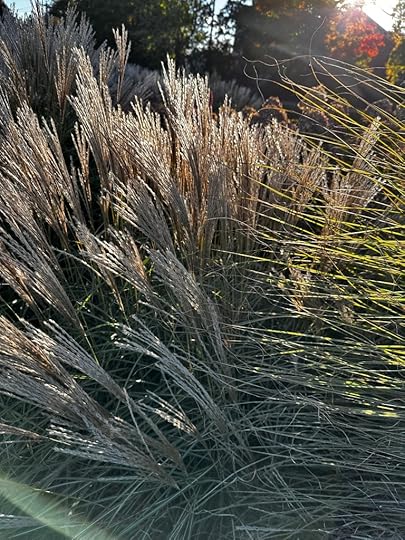
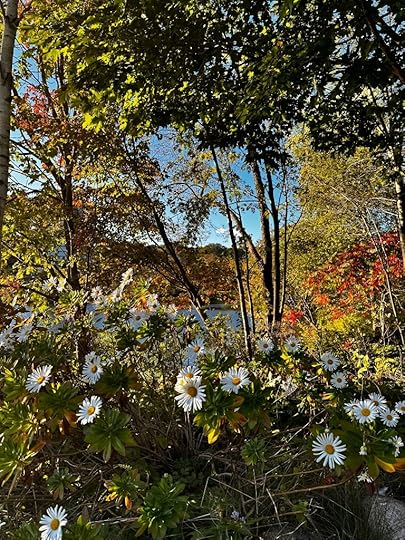
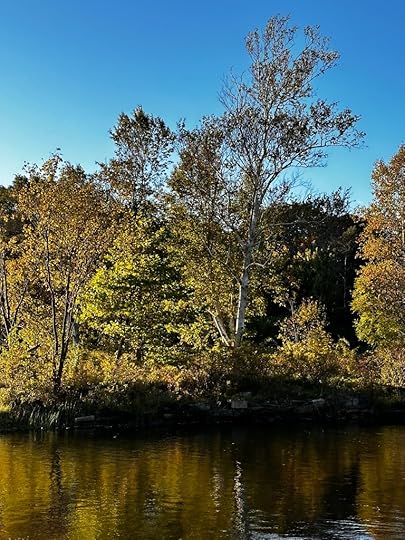

Here are the links to the last two posts, in case you missed them:
Peggy’s Cove and the Public Gardens
Read more about my books, including St. Paul’s in the Grand Parade, Jane Austen’s Philosophy of the Virtues, and Jane Austen and the North Atlantic, here.
If you enjoyed this post, I hope you’ll consider recommending it to a friend, and if you aren’t yet a subscriber, please sign up to receive future posts.
Copyright Sarah Emsley 2024 ~ All rights reserved. No AI training: material on http://www.sarahemsley.com may not be used to “train” generative AI technologies.
October 18, 2024
York Redoubt
Following on from last week’s post on Peggy’s Cove and the Public Gardens, I decided to put together a post with my recent photos from a hike at York Redoubt in Halifax. Hope you enjoy!

View of McNabs Island and Maugher’s Beach from York Redoubt
Along with the Halifax Citadel, Georges Island, Fort McNab, and the Prince of Wales Tower in Point Pleasant Park, York Redoubt is part of the Halifax Defence Complex. The fort at York Redoubt was built in 1793 on a bluff overlooking the entrance to Halifax Harbour, after war broke out between Britain and revolutionary France. Edward, Duke of Kent (and, later, father of the future Queen Victoria), improved the fortifications later in the 1790s, and the site was used by the military until 1956.

Peaceful and beautiful hiking trails wind around and through the old fort

Our dog with one of her best friends

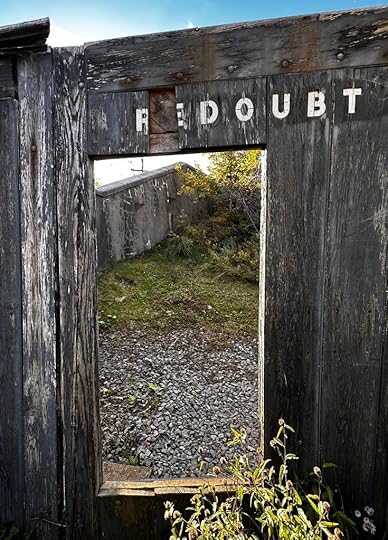

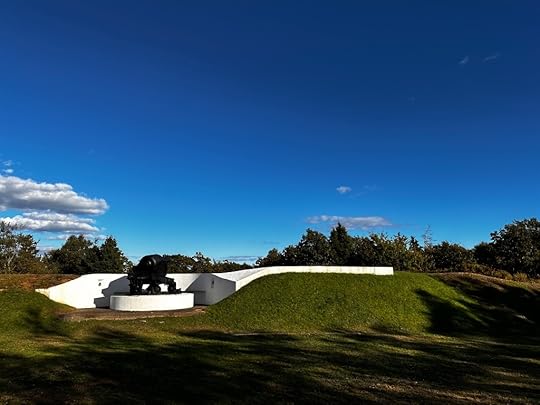

The Artillery Store and Canteen

The base of the Martello Tower
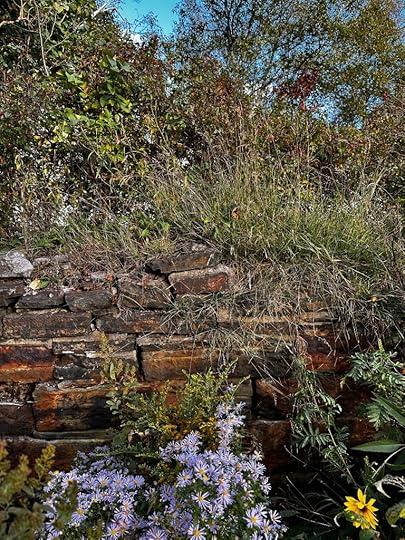
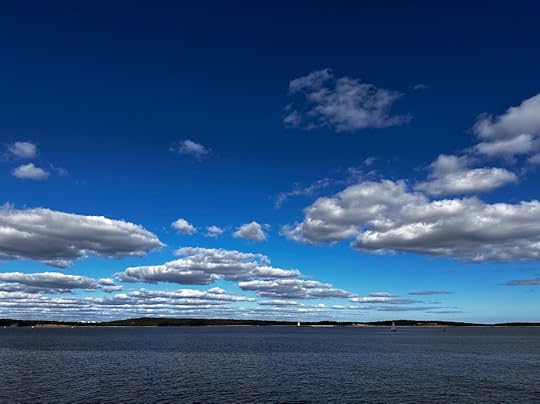
Looking across to McNabs Island

(I didn’t realize my husband was taking a picture of me when I took that picture of McNabs Island)
Good memories of a lovely Sunday afternoon hike with friends! Thanks for joining us.
While I’m thinking of York Redoubt and its beautiful trees, I want to recommend this inspiring profile of Diana Beresford-Kroeger in the Globe and Mail (it may be that you’ll need a subscription to read the full article). Beresford-Kroeger is a botanist who’s “internationally recognized for expanding the way we think about trees, who’s spent a lifetime defending something precious and knows time is growing short.” She’s the author of a new book called Our Green Heart, in which she urges readers to save our forests and plant new trees. “Every one of us on this Earth, can do at least a little,” she says. I loved the photos of her with some of the thousands of trees she and her husband have planted on their farm south of Ottawa, Ontario, including kingnut hickories, honey locust trees, cucumber trees (Magnolia acuminate), and a circle of forty-five black walnuts.
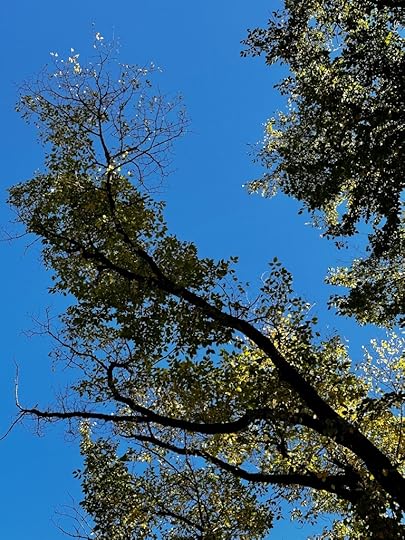
Right now I’m in Cleveland, Ohio for the Jane Austen Society of North America AGM, and I’m looking forward to hearing Susan Allen Ford’s plenary lecture on Jane Austen’s reading this morning. You may remember Susan’s wonderful guest post entitled “Jane Austen Talks to Mary Wollstonecraft: Thoughts on the Education of Marianne Dashwood.”
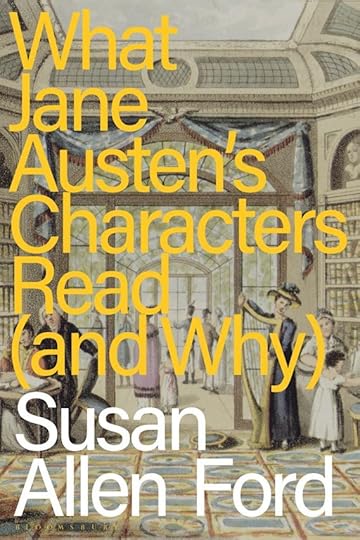
My own talk is tomorrow—wish me luck!
Here are the links to the last two posts, in case you missed them:
Peggy’s Cove and the Public Gardens
Read more about my books, including St. Paul’s in the Grand Parade, Jane Austen’s Philosophy of the Virtues, and Jane Austen and the North Atlantic, here.
If you enjoyed this post, I hope you’ll consider recommending it to a friend, and if you aren’t yet a subscriber, please sign up to receive future posts.
Copyright Sarah Emsley 2024 ~ All rights reserved. No AI training: material on http://www.sarahemsley.com may not be used to “train” generative AI technologies.
October 11, 2024
Peggy’s Cove and the Public Gardens
I visited two of the most beautiful places in Nova Scotia recently and I thought you might like to see my photos. If you’ve visited the famous Peggy’s Cove lighthouse, you will probably also recognize this view, which has been photographed and painted countless times.

It’s special to my family because in the 1970s, my husband’s grandmother, who lived in Calgary, painted these fishing sheds from a magazine photo—many years before she had the chance to visit Nova Scotia. Her painting hangs on the wall at our house, with the magazine photo and one of her snapshots taped to the back of the frame, and our family has fond memories of visiting Peggy’s Cove with her and her husband.
Here’s the lighthouse, followed by photos of the famous (and famously dangerous) rocks, along with a photo of “Fisherman’s Monument,” sculpted by William E. deGarthe from the granite in his backyard:
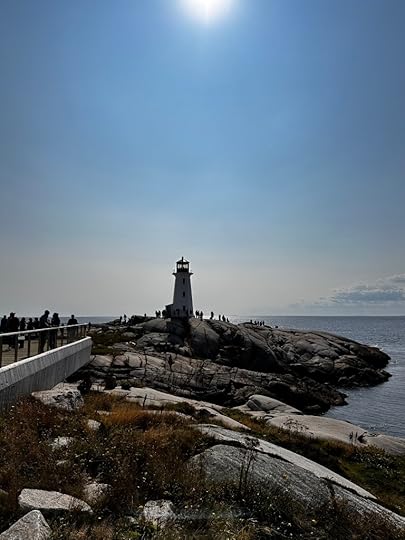
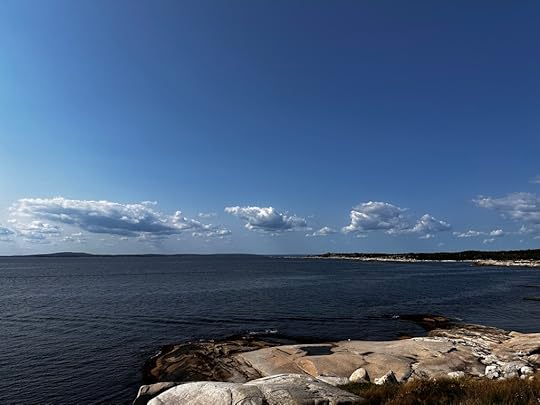
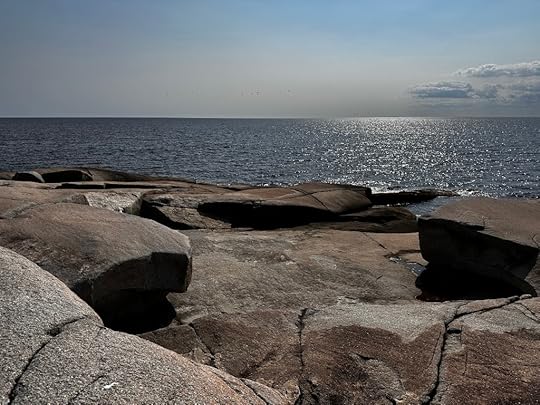
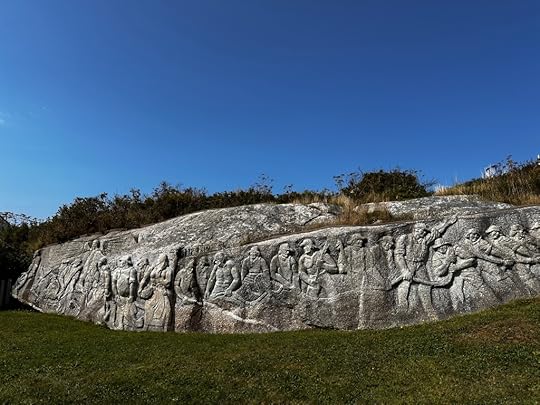
I spent a sunny afternoon in the Halifax Public Gardens with friends and I wandered around admiring the dahlias. I often think of L.M. Montgomery when I visit the Gardens, because I know she enjoyed walking there. (Several years ago I wrote a blog post on “L.M. Montgomery and the Halifax Public Gardens.”)
During her time as a student at Dalhousie University, Maud visited the Gardens on October 22, 1895 with her friend Lottie because they had received an assignment from their English professor, Archibald MacMechan, “to write a theme on them tomorrow.”
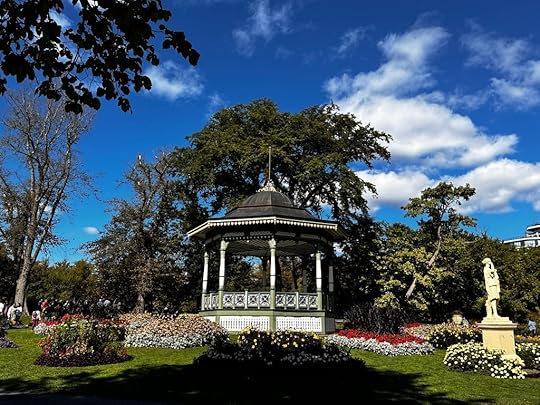

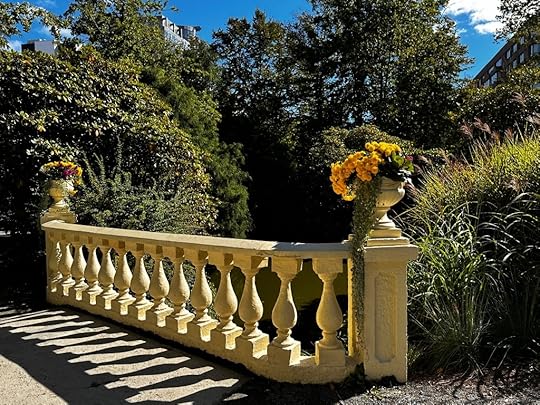

This upcoming lecture at Dalhousie may be of interest to those of you who live in Halifax: “Breaking Cassandra’s Curse: Crisis Prediction through Literature.” Next Thursday, October 17th, Professor Dr. Jürgen Wertheimer of the University of Tübingen will speak about Project Cassandra and his “thesis that literary texts can help identify tensions and regional and societal potentials for violence in their ‘latency phase’—years in advance.” More details here. (I wish I could go, but I’ll be at the Jane Austen Society of North America AGM.)
I heard recently (from Paula Bardell-Hedley’s Book Jotter) that Brona of This Reading Life is planning a #ReadingAusten project for 2025. Alongside her project, The Classics Club will be hosting a “sync read” of Jane Austen’s six major novels, beginning with Sense and Sensibility in January 2025, then Pride and Prejudice in March, and so on, with one novel every second month, in order of publication.
Here are the links to the last two posts, in case you missed them:
Happy October! (written by me)
A Calendar for Sense and Sensibility, by Ellen Moody
Read more about my books, including St. Paul’s in the Grand Parade, Jane Austen’s Philosophy of the Virtues, and Jane Austen and the North Atlantic, here.
If you enjoyed this post, I hope you’ll consider recommending it to a friend, and if you aren’t yet a subscriber, please sign up to receive future posts.
Copyright Sarah Emsley 2024 ~ All rights reserved. No AI training: material on http://www.sarahemsley.com may not be used to “train” generative AI technologies.



